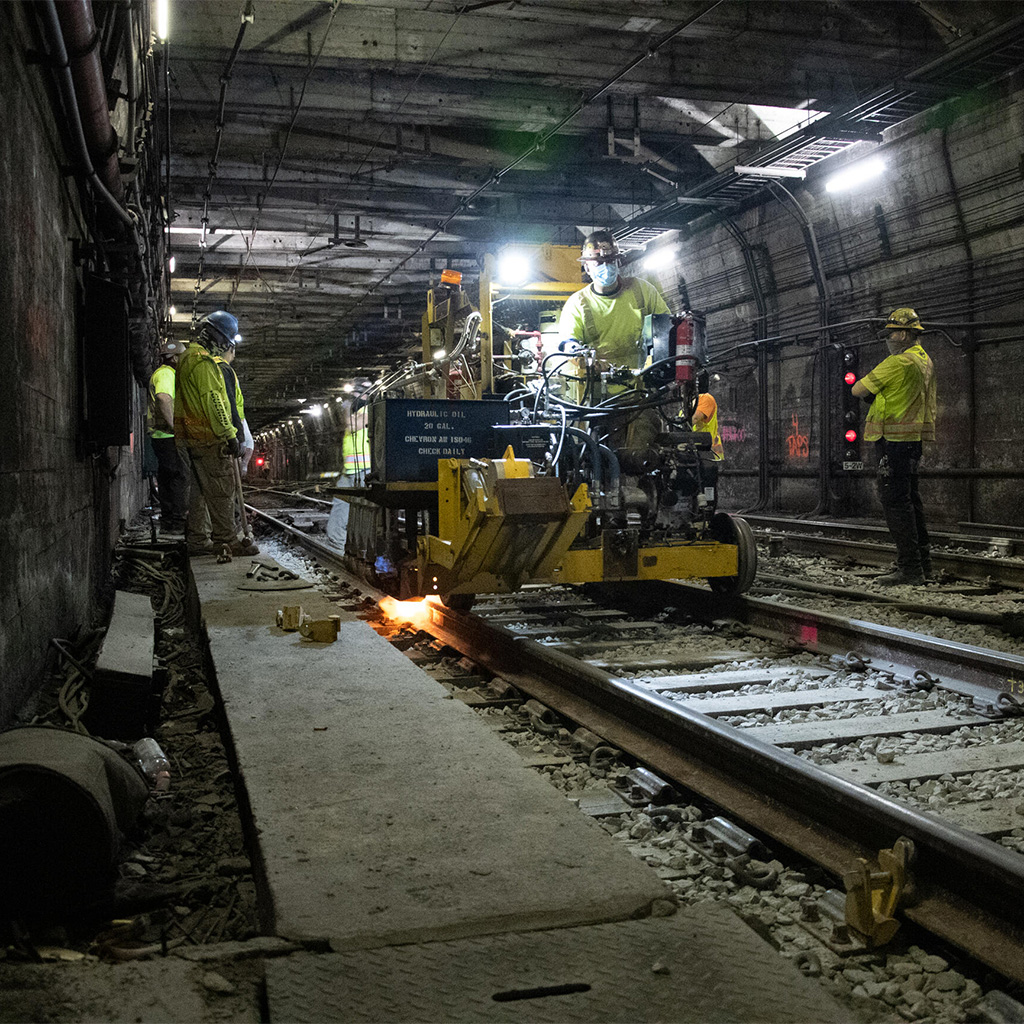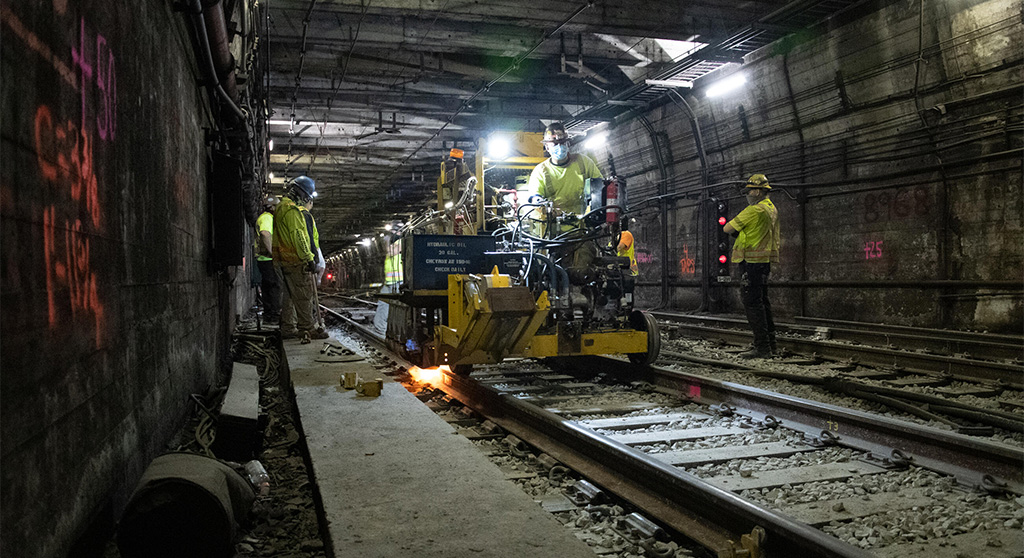MBTA releases speed-restriction dashboard, hears demand to reject stagnant ‘new normal’

An MBTA crew does the kind of repair that demands speed restrictions in an image from an MBTA dashboard posted Thursday.
The T has a speeding problem – or rather, a speed-restriction problem.
But now riders can check speed-restriction updates from the MBTA every morning on a Speed Restriction Tracker at mbta.com/speedrestrictions.
“Today’s dashboard provides daily updates on our data based on activity from the previous day and was launched with the goal of providing transparent and timely information to our customers,” interim general manager Jeff Gonneville said in a press release announcing the launch of the dashboard. “The dashboard delivers information that is clear and will assist riders in better understanding why they are experiencing slower conditions while riding the T. As we continue to validate and address track deficiencies, we also expect that over time this platform will demonstrate the progress we’re making to remove speed restrictions. We know these restrictions impact riders’ daily commutes and we will continue to be transparent about the ongoing, daily work to improve our transit system.”
Cambridge and Somerville riders won’t be shocked to learn that the red line leads in the number of restrictions: It has 106 as of Thursday, for 25 percent of its track (12 miles). The green line has 65 speed restrictions over 18 percent of track (9.5 miles). The orange line has 40 restrictions affecting 25 percent of its track too (5.6 miles). The blue line’s 10 restrictions affect 77 percent of its track (9.6 miles).
Speeds can drop to 10 mph from the 40 mph that is supposed to be standard.
Here’s how that looks on the dashboard:
TransitMatters, a public transportation advocacy group in Boston, has been keeping track of slow zones on its own website and said it will continue to do so even with the new tracker from the Massachusetts Bay Transportation Authority.
The gauges tell different sides of the story.
“TransitMatters’ dashboard tells you how much longer your commute will take,” said Ian Reynolds, the TransitMatters Lab co-chair. “The MBTA dashboard describes which part of the system have a low maximum speed limit. The TransitMatters dashboard measures the state of the system by quantifying where trains are running more slowly than the T’s own benchmarks say they should. In theory, the T’s descriptions and our measurements of slow zones should match closely.” TransitMatters intends to integrate the data from the Speed Restrictions tracker into its Slow Zone Dashboard “to help riders check that they actually do.”
Reynolds said riders know the T has been slow for a long time and just want a faster commute.
“Daily riders of the T already know that the system is slower than usual,” Reynolds said. “By publishing this dashboard, the T is acknowledging that specific segments of the system are too slow. We hope riders will use this new dashboard to hold the T accountable to specific improvements along specific segments.”
The transparency of the MBTA’s dashboard is a step in the right direction, he said. “Riders should take heart that the T is publicly acknowledging that slow zones have become a crisis – but what will win their confidence back is setting and meeting deadlines for the lifting of each speed restriction.”
Organizations such as TransitMatters and riders have been calling for more transparency from the T, which has suffered from slow zones and speed restrictions for years. The situation worsened two weeks ago with a temporary global speed restriction put on trains after the Department of Public Utilities requested track inspection documentation from the red line. Gonneville enacted the speed restrictions – fully lifted Sunday evening – after finding incomplete and missing documentation on track inspections. Now all four lines are being inspected and a third-party investigation is underway into how the organizational failure occurred.
Resisting “a new normal”
At an MBTA board meeting on Thursday, TransitMatters executive director Jarred Johnson blasted its misplaced focus and recent comments that called lower ridership since the pandemic began “a new normal.”
“I understood that this board wanted to do things differently, and I defended this in the press,” Johnson read in a statement to the board. “I understood that the previous amount of public comment and engagement with staff was not sustainable, but the pendulum has swung too far. I don’t think anyone would suggest that the hands-off approach has been successful.”
It’s time to reopen public meetings as a hybrid format so riders can attend in person or by Zoom, he told the board, calling the lack of live comment a “roadblock for meaningful engagement.”
“I must also address the patently offensive comments about T ridership and a ’new normal,’” he said. “We’re seeing ridership reach pre-pandemic levels in New York City. The stagnant ridership at the MBTA is a clear reflection of perceptions of safety, poor reliability, service cuts, slow zones and painful diversions.”
Johnson has been a vocal supporter of ridership, of public transit and of focusing on day-to-day operations so the T can offer and maintain service riders want to see.
“We are nearly nine months into service cuts on rapid transit and more than a year into bus service cuts,” he told the board. “This board needs a laser focus on hiring and service quality, not talk that reeks of managed decline.”
Cambridge Day reached out to the MBTA for a response to Johnson’s comments but did not hear back.
Leaders’ intentions
Gonneville has previously said that while he is interim GM, he is focused on the day-to-day operations, repairing trust in the T and repairing the service. Gov. Maura Healey made transit a major focus of her inauguration as well, vowing to hire a new leader quickly, a safety chief to oversee and inspect the system within 60 days and to secure funding to hire 1,000 operational workers for the T in the first year of her administration.
While no GM has yet to be hired, and service continues to face challenges because of a shortage of workers, the T is plowing ahead with maintenance work under Gonneville. It announced an April schedule for red line track improvements Thursday that will focus on rail and tie replacement work, including in the Cambridge area.
Shuttle buses will provide service between Kendall/MIT and JFK/UMass stations during weekends April 22-23 to alleviate speed restrictions near South Station and April 29-30 for more work near South Station and near the First Street gate in Cambridge.
Capital investment plan
The T also released a proposed 2024-2028 fiscal years capital investment plan for public comment Thursday. Comment will be accepted for 30 days.
It covers investments or activities related to acquiring, renewing, building, improving, maintaining, project planning and design – 600 capital projects to modernize, expand and increase the safety and reliability of the MBTA transit network, the T said.
The MBTA plans two virtual and one in-person public meetings to provide an overview:
- 6:30 p.m. March 30 via Zoom.
- 6:30 p.m. April 4 at the State Transportation Building, 10 Park Plaza, Boston.
- 6:30 p.m. April 12 via Zoom.
Meeting registration links, presentation materials and recordings will be at mbta.com/cip and mbta.com/events. Those unable to attend can comment via online CIP comment form, by sending an email to [email protected] or by mailing a letter to: MBTA Capital Investment Plan, 10 Park Plaza Suite 3830, Boston, MA 02116.




